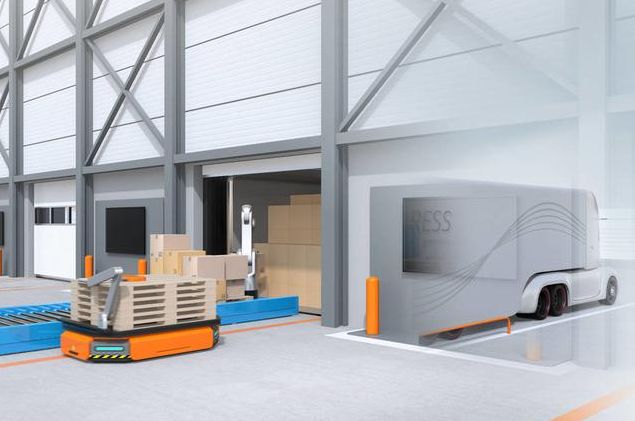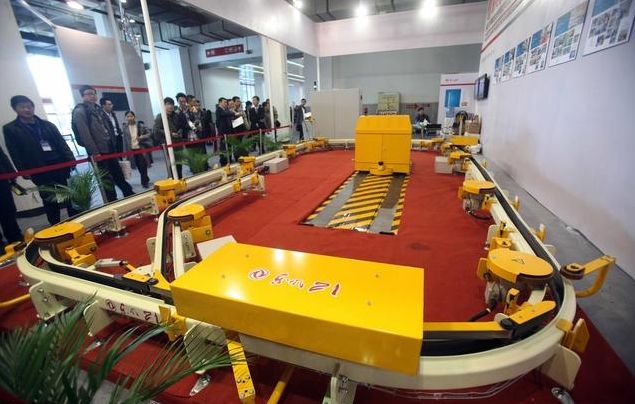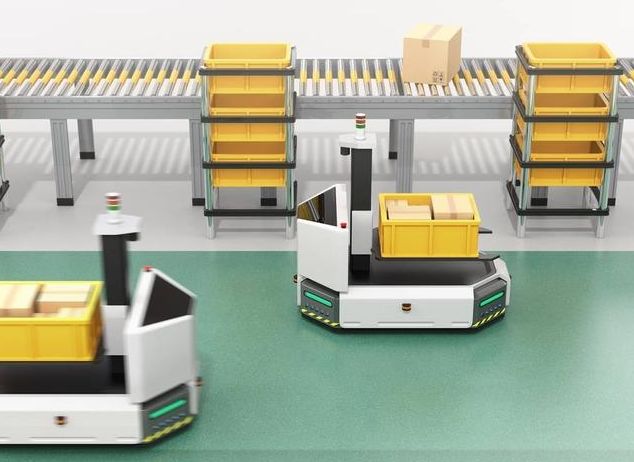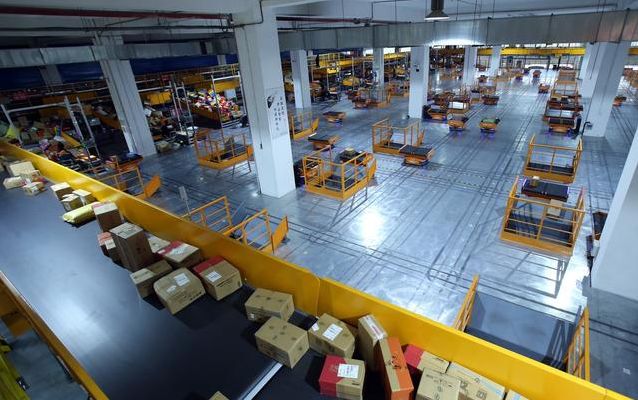

Key Technologies of AGV Navigation
AGV navigation refers to the process of controlling speed and steering angle based on the path offset to ensure that the AGV accurately reaches the target location and heading. It mainly involves three key technical points:
1. Positioning
Positioning determines the AGV’s position and heading relative to the global coordinates within the working environment, which is the most basic aspect of AGV navigation.
2. Environmental Perception and Modeling
To achieve autonomous movement of AGVs, various sensors are used to identify multiple environmental information such as road boundaries, ground conditions, and obstacles. AGVs determine reachable and unreachable areas in the forward direction through environmental perception, establish their relative position in the environment, and predict the movement of dynamic obstacles, thereby providing a basis for local path planning.
3. Path Planning
Depending on the extent of environmental information available to the AGV, it can be divided into two types: global path planning based on known environmental information and local path planning based on sensor information, where the environment is unknown or partially unknown. This means that information about the size, shape, and location of obstacles must be obtained through sensors.

Common AGV Navigation Methods
1. Magnetic Pin Navigation
This navigation method still detects magnetic signals from magnetic pins using magnetic navigation sensors to find the travel path. It changes the original continuous sensing of magnetic strips to intermittent sensing, so the distance between magnetic pins cannot be too large. The AGV must be in a distance measurement state between two magnetic pins, requiring an encoder to measure the distance traveled. Additionally, the control module used for magnetic pin navigation is the same as that for magnetic strip navigation.
Advantages of magnetic pin navigation: low cost, mature and reliable technology. The navigation is discreet and aesthetically pleasing, meaning that magnetic pins are embedded below the surface of the ground, and there are no other navigation aids above the factory floor. Magnetic pins are resistant to interference, wear, and the effects of acid, alkali, and oil. They can be used outdoors, indoors, and even in the rain.
Disadvantages of magnetic pin navigation: the AGV navigation surface must meet technical requirements, meaning that no other magnetic materials can exist along the AGV navigation route; there must be no demagnetizing or anti-magnetic materials affecting the magnetic properties of the AGV pins. The magnetic pin navigation route is laid out once, and subsequent modifications require additional work. Compared to laser navigation technology, magnetic pin navigation increases costs and construction time for later modifications. The construction of magnetic pin navigation will cause some damage to the surface, requiring drilling and backfilling, demanding strict construction techniques to restore the original aesthetic requirements of the surface.

2. Magnetic Strip Navigation
Magnetic strip navigation is considered a very mature technology, primarily obtaining the vehicle’s position deviation relative to the target tracking path by measuring the magnetic field signals along the path, thus achieving vehicle control and navigation. Magnetic strip navigation has high measurement accuracy and good repeatability, and is less affected by changes in lighting. During operation, the magnetic sensing system is highly reliable and robust. Once the magnetic strip is laid, maintenance costs are very low, and its lifespan is long, making it easy to add or change paths.
Advantages of magnetic strip navigation: simple on-site construction, low cost, mature and reliable technology, and no interference from sound or light. The AGV operation path is clearly defined, and secondary changes to the path are easy, with low costs and short change cycles. The technical requirements for construction personnel are low.
Disadvantages of magnetic strip navigation: magnetic strips are prone to damage; the overall aesthetics decrease due to the installation of magnetic strips on the ground. Magnetic strips cannot be continuous; due to AGV turns, some magnetic strips may be crushed and not laid. Magnetic strips can attract metal objects, causing AGV equipment failures. Other sensors are required to achieve positioning station functions.

3. Laser Navigation
Laser navigation involves installing laser reflectors around the AGV’s travel path. The AGV emits laser beams while collecting the reflected beams from the reflectors to determine its current position and direction, achieving navigation through continuous triangular geometric calculations.
Advantages of laser navigation technology: precise AGV positioning. The ground does not require additional positioning facilities, allowing for flexible and variable travel paths that can adapt to various on-site environments. This is currently the preferred advanced navigation method for many AGV manufacturers both domestically and internationally.
Disadvantages of laser navigation technology: high costs, relatively strict environmental requirements (external light, ground requirements, visibility requirements, etc.). The price of laser navigation equipment is high, and it is suitable for environments without obstructions. The cost of reflectors is also high.
Currently, laser navigation technology has become the mainstream solution for AGV manufacturers due to its high positioning accuracy, flexible path changes, and mature navigation technology.

4. Electromagnetic Navigation
Electromagnetic navigation is one of the more traditional navigation methods still in use today. It involves embedding metal wires along the AGV’s travel path and loading guiding frequencies onto these wires. By recognizing these guiding frequencies, the AGV achieves navigation functionality. This navigation technology is similar to magnetic strip navigation. Due to its aesthetic shortcomings and difficulties in path changes, this technology is gradually being abandoned by AGV manufacturers, but it is still suitable for specific situations based on the AGV’s working environment requirements, such as in high-temperature environments or where strict path straightness is required.
Advantages of electromagnetic navigation: low cost, mature and reliable technology. The navigation is discreet and aesthetically pleasing, meaning that magnetic pins are embedded below the surface of the ground, and there are no other navigation aids above the factory floor. Magnetic pins are resistant to interference, wear, and the effects of acid, alkali, and oil. They can be used outdoors, indoors, and even in the rain.
Disadvantages of electromagnetic navigation: requires additional equipment to generate electromagnetic signals. Other sensors are needed to achieve station positioning functions. The AGV electromagnetic navigation route is laid out once, and subsequent modifications require additional work. Compared to laser navigation technology, electromagnetic navigation increases costs and construction time for later modifications. The construction of electromagnetic navigation will cause some damage to the surface, requiring drilling and backfilling, which demands strict construction techniques to restore the original aesthetic requirements of the surface.

5. Distance Measurement Navigation
This navigation technology mainly applies laser two-dimensional scanners to scan and measure the surrounding environment, obtaining measurement data, which is then combined with navigation algorithms to achieve AGV navigation. This navigation sensor usually uses safety laser scanners with safety features, allowing for both safety functions and navigation measurement functions. AGVs using distance measurement navigation technology can automatically pick up and deliver goods inside containers.
6. Contour Navigation
Contour navigation is currently the most advanced navigation technology for AGVs. This technology uses two-dimensional laser scanners to measure and learn about the on-site environment, creating a navigation map, and correcting it through multiple measurement learnings to achieve contour navigation functionality. It uses natural environmental features (walls, columns, and other fixed objects) for free distance measurement navigation, updating its position based on environmental measurement results. Advantages of contour navigation: no need for reflectors or other artificial landmarks; reduced installation costs; less maintenance work; a viable alternative to laser navigation.
7. Hybrid Navigation
Hybrid navigation is a combination of multiple navigation methods, created in response to changes in the on-site environment. When a certain navigation method temporarily cannot meet the requirements due to environmental changes, it switches to another navigation method to continue meeting the AGV’s continuous operation needs.

8. Optical Navigation
Optical navigation utilizes industrial cameras for recognition. This navigation can include color band tracking navigation, QR code recognition, and other functions.
9. QR Code Guidance
The QR code guidance method involves discretely laying out QR codes and using the AGV’s onboard camera to scan and parse the QR codes to obtain real-time coordinates. This method is one of the most common AGV guidance methods currently on the market. The combination of QR code guidance and inertial navigation is also widely used, with Amazon’s KIVA robots achieving autonomous movement through this navigation method. This method is relatively flexible, making it easy to lay out and change paths, but the QR codes are prone to wear and require regular maintenance.
Applicable scenarios: warehouses with good environments.
10. Inertial Navigation
Inertial navigation involves installing a gyroscope on the AGV, which can obtain the AGV’s three-axis angular velocity and acceleration. Through integral calculations, it navigates and positions the AGV. The advantages of inertial navigation are low cost and high precision in a short time. However, the disadvantages of this navigation method are particularly evident; the gyroscope accumulates error over time, leading to a loss of position, which is a significant drawback. As a result, inertial navigation is often used as an auxiliary method to other navigation methods. As mentioned earlier, the combination of QR code guidance and inertial navigation uses inertial navigation in blind spots between QR codes, recalibrating the position when passing through QR codes.

11. SLAM Laser Navigation (Natural Navigation)
SLAM laser navigation is a natural navigation method that does not require the use of reflectors. It no longer needs auxiliary navigation markers (QR codes, reflectors, etc.) but uses natural environmental features in the working scene, such as columns and walls in warehouses, as reference points for positioning and navigation. Compared to traditional laser navigation, its advantage is lower manufacturing costs. According to my understanding, some manufacturers (such as SICK) have developed laser sensors suitable for outdoor AGV operations.
12. Visual Navigation
Visual navigation is also a navigation method based on SLAM algorithms. This navigation method collects image information from the operating area using onboard visual cameras and processes this image information for positioning and navigation. Visual navigation has high flexibility, a wide range of applications, and low costs, but its technical maturity is generally average, and the technology for quickly and accurately recognizing road signs using onboard visual systems is still at a bottleneck stage.
Comparison of AGV Navigation Methods
Early AGVs mostly used magnetic strips or electromagnetic navigation. These two solutions have simple principles, mature technology, and low costs, but changing or expanding paths and subsequent maintenance can be cumbersome. Additionally, AGVs can only travel along fixed routes, making it impossible to achieve intelligent avoidance or real-time task changes through control systems.
Currently, the mainstream navigation method for AGVs is QR code + inertial navigation. This method is relatively flexible, making it easy to lay out or change paths, but the paths require regular maintenance. In complex environments, frequent changes of QR codes may be necessary, and there are strict requirements for the precision and lifespan of the gyroscope.
With the development of SLAM algorithms, SLAM has become the preferred advanced navigation method for many AGV manufacturers. SLAM does not require other positioning facilities, offers flexible and variable paths, and can adapt to various on-site environments. It is believed that with the maturity of algorithms and the reduction of hardware costs, SLAM will undoubtedly become the mainstream navigation method for AGVs in the future.
SLAM can be roughly divided into two main categories: laser SLAM (2D or 3D) and visual SLAM.
Visual SLAM is still in the stage of further research and expansion of application scenarios. Due to its advantages of large information volume and wide applicability, visual SLAM has received widespread attention. However, the algorithm has high requirements for processors, often requiring quasi-desktop-level CPUs or even GPUs. In contrast, AGVs mostly use embedded processors, making it difficult to apply on a large scale in small AGV devices in the short term.
Laser SLAM started earlier than visual SLAM, with relatively mature theories and technologies, and its stability and reliability have been verified. Additionally, the performance requirements for processors are much lower than those for visual SLAM. For example, mainstream laser SLAM can run in real time on ordinary ARM CPUs. Some AGV manufacturers have already launched products based on laser SLAM navigation. Undoubtedly, laser SLAM will remain the mainstream SLAM solution for some time.
AGV navigation technology continues to develop towards higher flexibility, higher precision, and stronger adaptability, with decreasing reliance on auxiliary navigation markers. Instantaneous positioning and map construction through SLAM is undoubtedly the future trend. It is believed that in the near future, the interaction and integration of technologies such as 5G, AI, cloud computing, and IoT with intelligent robots will bring tremendous changes to the AGV industry, and SLAM navigation methods with higher flexibility, higher precision, and stronger adaptability will be better suited to complex and dynamic operational environments. After the joint development of multiple disciplines, more advanced AGV navigation technologies will certainly emerge in the future.
Source: Industrial Robot Expert
-
Automotive Engineer Magazine 2020 Annual Index -
Research on Various RFID Hybrid Tracking Systems for Smart Factories -
Domestic Car Sales Ranking Shows Significant Growth in Domestic Cars, The Rise of Chinese Cars! -
Can Chinese Cars Continue to Survive Without Foreign Investment or Joint Ventures? -
The Necessity and Goals of Building a Digital Factory for New Energy Batteries -
Plan for Building a Digital Factory for New Energy Batteries -
Simulation of Power System Matching and Driving Range for Pure Electric Vehicles -
The Best Solution for Transitioning from Fuel Vehicles to Pure Electric Vehicles -
What is the Lightest in Automotive Lightweight Applications? -
Ren Zhengfei’s Recommended 5G Empowerment, This PPT Lets You Know All the Content. -
Exploring Aluminum Body Connection Technology -
Great Wall’s Xushui Smart Factory: 286 Robots Create Luxury and Safety for VV5s